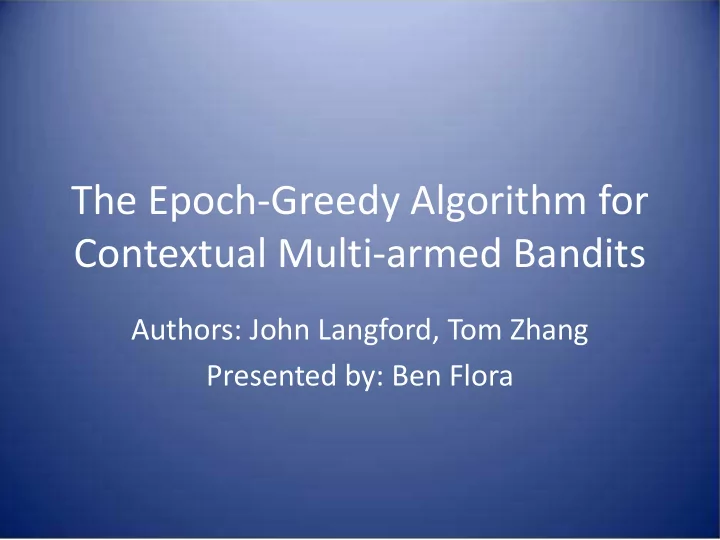

The Epoch-Greedy Algorithm for Contextual Multi-armed Bandits Authors: John Langford, Tom Zhang Presented by: Ben Flora
Overview • Bandit problem • Contextual bandits • Epoch-Greedy algorithm
Overview • Bandit problem • Contextual bandits • Epoch-Greedy algorithm
Bandits • K arms each arm i – Wins (reward 1) with probability p i – Looses (reward 0) with probability 1- p i • Exploration vs. Exploitation – Exploration is unbiased – Exploitation is biased by exploration only • Regret – Max return – Actual return
Web Example • Some number of ads that can be displayed – Each ad translates to an arm • Each ad can be clicked on by a user – If clicked reward 1 if not reward 0 • Want to have adds clicked as often as possible – This will make the most money
Overview • Bandit problem • Contextual bandits • Epoch-Greedy algorithm
Contextual Bandits • Add Context to the bandit problem – Information aiding in arm choosing – Helps know which arm is best • The rest follows the Bandit problem • Want to find optimal solution • More useful than regular bandits
Web Problem • Now we have user information – A user profile – Search Query – A users preferences • Use this information to choose an ad – Better chance of choosing an ad that is clicked on
Overview • Bandit problem • Contextual bandits • Epoch-Greedy algorithm
Epoch-Greedy Overview Exploration (unbiased input) Hypotheses Black Box: (best arm) Transforms Input to hypotheses Context Similar idea to the papers we saw on Thursday
Exploration • Look at a fixed time horizon – Time horizon is the total number of pulls • Choose a number of Exploration steps n steps T-n Steps Exploration Exploitation T
Minimizing Regret • No explore regret = T • All exploit regret = T • Some minimum between those points Regret Regret Regret T T T n n n T T T
Creating a Hypotheses • Simple two armed case • Remember binary thresholds • Want to learn the threshold value t ε ε If x < t : pick arm 1 x > t : pick arm 2
Creating a Hypotheses (Cont.) • Want to be within ε of the threshold – Need ≈ O(1/ε ) • As the function gets more complex – Need ≈ O((1/ε )*C) – C denotes how complex the function is – A quick note for those of you who took 156 the C is similar to VC dimension
Epoch • Don’t always know the time horizon • Append groupings of known time horizons – Repeat until time actually ends • This specific paper has chosen a single exploration step at the beginning of each epoch
Epoch-Greedy Algorithm • Do a single step of exploration – Begin creating an unbiased vector of inputs to create the hypotheses – Observe context information • Add the learned information to past exploration and create a new hypotheses – This uses the contextual data and exploration • For a set number of steps exploit the hypotheses arm
Review Using Web Example • Have a variety of ads that can be shown – Sports – Movie – Insurance
Review (Cont) • Search Query – Golf Club Repair – Randomly choose – Clicked • Search Query – Car Body Repair – See Repair and Car – Not Clicked
Review (Cont.) • Search Query – Horror Movie – Randomly choose – Clicked • Search Query – Sheep Movie – See Sheep and Movie – Clicked
Recommend
More recommend